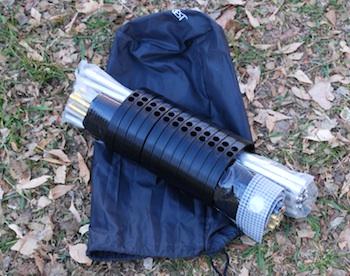Finding a comfortable position sleeping on the ground can be challenging, what with rocks, roots, and the general lack of a perfectly flat piece of turf. For those conditions, you just might want to consider adding a cot to your gear bag.
Therm-A-Rest offers two models, the LuxuryLite Ultralite Cot that weighs in at 2 pounds, 12 ounces, and the somewhat heftier LuxuryLite Mesh Cot that weighs a pound more.
Design engineers are crafty folks, as evidenced by the way these cots are both packed and assembled. The support rods and poles are aluminum shafts that quickly assemble, the "feet" are plastic, and the cot surface is either a laminated, waterproof nylon (Ultralite) or a breathable mesh. The rods and cot surface fit inside the plastic feet, creating a portable package 16 inches long by 6 wide.
Assembled, the Ultralite measures 6 feet by 2 feet, while the Mesh version is 6 feet by 2 feet, 2 inches.
Assembling can initially appear daunting when you're confronted by a pile of cross-shafts and shock-corded poles, a dozen plastic feet, and a length of nylon or mesh. But with a glance or three at the instructions, building your cot is really quite easy.
The shock-corded poles are inserted into sleeves on the long edges of the nylon or mesh surface; the shorter rods are used to create "bows" by connecting a "male" and "female" rod into one longer rod that is held by two feet -- one on each end. The feet have small hooks on them that clamp onto the poles running the length of the fabric; assemble six bows and attach them to the poles, and you've got a cot.

Ready for assembly.

Ready for use.
Therm-A-Rest suggests one of two setups: one that employs four single bows and two "twist" bows, which are created by using four rods inserted into two feet, and one that simply relies on four bows. The difference is that the first setup is stronger and offers a firmer cot, while the second is quicker to assemble yet isn't quite as firm.
Do they work? They do indeed. Your slumber is a more comfortable being off the harder ground. In summer you'll also get a bit more air ventilation. Conversely, in colder weather you'd want to place an insulating sleeping pad on the cot beneath your sleeping bag.
Now, even the ultralight version is a bit hefty if you're heading off on a long backpack trek if you're trying to keep your pack weight to a minimum. However, if you're traveling the backcountry by canoe or kayak, rafting a river, or car camping, this is a great solution to a potentially uncomfortable night on the ground.

Therm-A-Rest's cots cushion your sleeping experience. Photo by Ian Coble.




Add comment